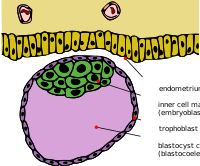
Photo from wikipedia
Abstract Purpose: The existing literature is scarce regarding outcomes of fresh vs frozen embryo blastocyst transfers in women with endometrioma. The goal of the study was to compare outcomes between… Click to show full abstract
Abstract Purpose: The existing literature is scarce regarding outcomes of fresh vs frozen embryo blastocyst transfers in women with endometrioma. The goal of the study was to compare outcomes between fresh and frozen blastocyst transfers (fresh-BT vs. frozen-BT) in endometrioma-affected women. Materials and methods: This study included 315 endometrioma-affected women aged between 20 and 39 years who underwent blastocyst transfer. Primary outcome was live birth rate (an alive birth after 24 completed weeks gestation). Results: The study groups did not differ in terms of patient characteristics and treatment variables. The live birth rate was 40.7% in fresh-BT group and 56.1% in frozen-BT group (OR:1.86, 95% CI:1.18–2.92 p = .007). The approach of frozen embryo transfer was an independent factor of live birth (adjusted OR:1.83, 95% CI:1.16–2.90, p = .009). Conclusion: The approach of frozen blastocyst transfer increases the chance of live birth in endometrioma-affected patients compared with fresh blastocyst transfer. Thus, a frozen embryo transfer may be the choice of strategy in these patients.
Journal Title: Gynecological Endocrinology
Year Published: 2020
Link to full text (if available)
Share on Social Media: Sign Up to like & get
recommendations!